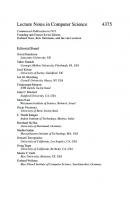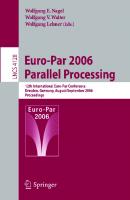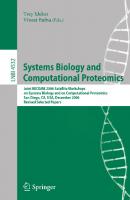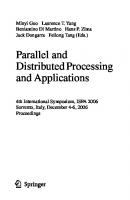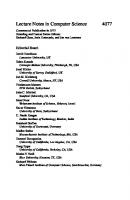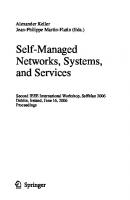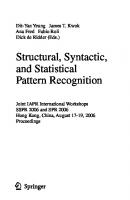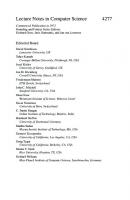Euro-Par 2006 Workshops: Parallel Processing: CoreGRID 2006, UNICORE Summit 2006, Petascale Computational Biology and Bioinformatics, Dresden, ... (Lecture Notes in Computer Science, 4375) 9783540722267, 3540722262
This book constitutes the thoroughly refereed joint post-proceedings of the three International Workshops on Grid Middle
124 45 13MB
English Pages 347 [339] Year 2007
Table of contents :
Title page
Preface
Organization
Table of Contents
CoreGRID Workshop onGRID Middleware
Introduction
Architecture of a Network Monitoring Element
Introduction
Inside View of a Network Monitoring Element
The Passive Network Monitoring Component
Outline of a Secure Group Membership Scheme
Related Work
Conclusions
Support for Automatic Diagnosis and DynamicConfiguration of Scalable Storage Systems
Introduction
Global Reconfiguration
Directed Reconfiguration
Related Work
Conclusions
Adding Dynamism to OGSA-DQP:Incorporating the DynaSOAr Framework inDistributed Query Processing
Introduction
Brief Description of OGSA-DQP
DynaSOAr Architecture
Dynamic OGSA-DQP
Implementation
Experiment
Setup
Results and Analysis
Related Work
Current and Future Directions
Conclusion
Review of Security Models Applied toDistributed Data Access
Introduction
Definitions
Grid Data Management Systems
Security
Requirements
Data Types
Data Management Security Technologies
Authentication
Authorization
Local Security Enforcement
Building a Grid Data Access Framework
Conclusions
Security Requirements Analysis for Large-ScaleDistributed File Systems
Introduction
FileStamp Architecture
Security Requirements of FileStamp
Generic Requirements
Specific Requirements
Solutions for the FileStamp Security Requirements
Authentication
Authorization
Availability, Confidentiality, and Integrity
Resilience and Fault Tolerance
Data Lifecycle Management (DLM)
Conclusions
References
Coupling Contracts forDeployment on Alien Grids
Introduction
Related Work
Coupling Matches with Contracts
Clause Types
Typed Clauses
Coupling Interfaces
Coupling Contracts
Matching Parties: Descriptors and Applications Example
Coupling Distributed Applications with Deployment on the Grid
Background on ProActive Deployment Descriptors
The Problematic of Applications and Descriptors
Clause Types
Clauses in ProActive Descriptors
Clauses in ProActive Applications
Constraints
Conclusions and Future Work
A Transparent Framework for HierarchicalMaster-Slave Grid Computing
Introduction
Related Work
TMS Framework
Reflection-Based Implementation
MOP-Based Implementation
Programming Model
User QoS Requirements
Framework Evaluation
Conclusion
References
A Multi-level Scheduler for the Grid ComputingYML Framework
Introduction
YML Framework
YML Advantages
Component Creation
Application Creation with YvetteML
A Multi-level Scheduling Model in YML
An Economic Model
Scheduling Scenario
Access Policy
Case Study
Features for the Scheduling Model
Conclusions and Perspectives
Virtual Environments - Framework forVirtualized Resource Access in the Grid
Introduction
Comparison of VA and VM
Virtual Workspaces Approach
Architecture of the Framework
Accounting and Audit
Conclusions
Grid Meta-Broker Architecture:Towards an Interoperable GridResource Brokering Service
Introduction
Related Work
Abstract Architecture
Conclusions
A Super-Peer Model for Multiple JobSubmission on a Grid
Introduction
Job Assignment and Data Download
Performance Evaluation
Conclusions
References
A Scheduling Algorithm for High PerformancePeer-to-Peer Platform
Introduction
What Is a Real Peer-to-Peer System?
XtremWeb
The Coordinator
Workers
XtremWeb-CH
Automatic Execution of Parallel and Distributed Applications
Granularity and Scheduling
Direct Communication
Monitoring Tools
Experimental Measures
Conclusion
References
Brokering Multi-grid Workflowsin the P-GRADE Portal
Introduction
The P-GRADE Portal
Workflow Management in the P-GRADE Portal
Workflow Notation
Developing and Editing Workflows
Workflow Execution
Workflow Management in Details
Multi-grid Workflow Brokering
Related Work
Summary and Conclusions
Diet: New Developments and Recent Results
Introduction
DIET Architecture
DIET Scheduling
Plug-In Schedulers
Collectors of Resource Information
DIET Batch Scheduler Management
DIET Workflow Management
DIET Deployment
DIET Fault-Tolerance
Fault Detection
MA Topology Recovery
Checkpoint/Restart Mechanism
DIET Visualization and Large Scale Validation
DIET Applications
A BLAST Application Using DIET
Cosmological Simulation with RAMSES and Galics
Conclusion and Future Work
Execution Support of High PerformanceHeterogeneous Component-Based Applicationson the Grid
Introduction
Component Deployment in a Multi-middleware Heterogenous Environment
Related Work
The ASSIST Environment Architecture
Grid Execution Agent Design
Core Deployment Cycle
A Modular Multi-middleware Architecture
Conclusion and Future Work
Towards a Grid Information Knowledge Base
Introduction
A Core Grid Ontology Framework
Building a Grid Knowledge Base Using CGO
Querying a Grid Knowledge Base
Conclusions
UNICORE Summit 2006
Introduction
A Versatile Execution Management System forNext-Generation UNICORE Grids
Introduction
Experiences with UNICORE
The UNICORE NJS: A Gap Analysis
Requirements for a Next-Generation NJS
The XNJS: Design and Implementation of a Next-Generation UNICORE NJS
Core Architecture
Execution Management
Security
Status of the XNJS
Conclusions and Outlook
Towards More Flexible and Increased Securityand Privacy in Grids
General Remarks
Identification and Authorisation in an Organisation
Identification
Attributes of Entities
Authorisation
Organisations in the Grid
Identification and Authentication on the Grid
Authorisation Based on Identity
Authorisations Based on Properties of the Entities
User Database at the Grid Resource Site
Managing Authorisation for VOs
The Attributes of Requestors in Their Organisation
The Attributes of Requestors in the VO
Privacy --- Anonymity
Attributes of the Resources
Authorisation
Consequences for the UNICORE Development
Authentication
A First Use of Attributes: The Explicit Trust Delegation
The Proposed Authorisation Architecture
Attribute Authorities
Authorisation
Authorisation in the Non-UNICORE World
VOMS
Shibboleth
GridShib
PERMIS
GridShibPERMIS
Conclusion
Integration of Grid Cost Model into ISS/VIOLAMeta-scheduler Environment
Introduction
Application Component Characteristics
Embarrassingly Parallel Application Components
Application Components with Point-to-Point Communications
Application Components with Multicast Communication Needs
Components Demanding Shared Memory
Meta-scheduling Features
The Broker
Action List
Decision: Grid Cost Model
Epilogue: Prepare Data for Next Execution
Simulator to Tune Parameters
Conclusions
A One-Stop, Fire-and-(Almost)Forget,Dropping-Off and Rendezvous Point
Introduction
Atomic Services and Interoperation
Functionality
Java Business Integration
Orchestration
Domain Specific Languages
BPEL
Rules
Summary
Grid-Based Processing of High-VolumeMeteorological Data Sets
Introduction
Challenges to Be Addressed
Transfer of Large Data Sets
Parallelization
Solution Approaches Employing Grid Technologies
Globus Toolkit 4
Application Scenario.
Data Transfers with Globus Toolkit 4.
Condor
Application Scenario.
The Condor Approach.
UNICORE
Conclusions and Future Work
BLAST Application on the GPE/UnicoreGSGrid
Introduction
BLAST Software
Grid Programming Environment (GPE)
BLAST GridBean for GPE
Conclusions and Future Work
Job Management Enterprise Application
Introduction
Requirements for a Job Management Application
Architecture and Implementation of the Job Management Enterprise Application (JMEA)
The Arcon Client Library
The Components
Security
Conclusion and Outlook
UNICORE Deployment Within the DEISASupercomputing Grid Infrastructure
Introduction
DEISA
Infrastructure Overview
UNICORE
UNICORE Components
UNICORE and DEISA Infrastructure Integration
UNICORE Deployment for DEISA
Integration of UNICORE with DEISA Batch Scheduling Systems and GPFSMulti Cluster
The Final Picture
Conclusions
References
Petascale ComputationalBiology and Bioinformatics
Introduction
Progress in Scaling Biomolecular Simulations toPetaflop Scale Platforms
Introduction
Experiences with Blue Gene/L
Peta-scale Challenges
Molecular Simulation Validity
Performance and Scalability
Algorithmic Explorations
Conclusions
Progress Towards Petascale Applications inBiology: Status in 2006
Introduction
Methods and Materials
Results
Discussion
Conclusion
Toward a Solution of the Reverse EngineeringProblem Using FPGAs
Introduction
Dealing with Large Genetic Networks
Finite Field Multiplication
A New FPGA-Based Approach
Experimental Results
Conclusions and Future Work
Two Challenges in Genomics That Can Benefitfrom Petascale Platforms
Introduction
Genomic Signatures for Monitoring the Rate of Accumulation of Somatic Mutations
Optimal Combinations of Genomic Signatures for Human HLA Typing
Conclusions
High Throughput Image Analysis onPetaFLOPS Systems
High Throughput Image Analysis
Performance and Limitations
Suggested Changes to Scale Up to PetaFLOPS Systems
Introduce Distributed Storage of Data
Improve Communication and Job Control
Author Index
Title page
Preface
Organization
Table of Contents
CoreGRID Workshop onGRID Middleware
Introduction
Architecture of a Network Monitoring Element
Introduction
Inside View of a Network Monitoring Element
The Passive Network Monitoring Component
Outline of a Secure Group Membership Scheme
Related Work
Conclusions
Support for Automatic Diagnosis and DynamicConfiguration of Scalable Storage Systems
Introduction
Global Reconfiguration
Directed Reconfiguration
Related Work
Conclusions
Adding Dynamism to OGSA-DQP:Incorporating the DynaSOAr Framework inDistributed Query Processing
Introduction
Brief Description of OGSA-DQP
DynaSOAr Architecture
Dynamic OGSA-DQP
Implementation
Experiment
Setup
Results and Analysis
Related Work
Current and Future Directions
Conclusion
Review of Security Models Applied toDistributed Data Access
Introduction
Definitions
Grid Data Management Systems
Security
Requirements
Data Types
Data Management Security Technologies
Authentication
Authorization
Local Security Enforcement
Building a Grid Data Access Framework
Conclusions
Security Requirements Analysis for Large-ScaleDistributed File Systems
Introduction
FileStamp Architecture
Security Requirements of FileStamp
Generic Requirements
Specific Requirements
Solutions for the FileStamp Security Requirements
Authentication
Authorization
Availability, Confidentiality, and Integrity
Resilience and Fault Tolerance
Data Lifecycle Management (DLM)
Conclusions
References
Coupling Contracts forDeployment on Alien Grids
Introduction
Related Work
Coupling Matches with Contracts
Clause Types
Typed Clauses
Coupling Interfaces
Coupling Contracts
Matching Parties: Descriptors and Applications Example
Coupling Distributed Applications with Deployment on the Grid
Background on ProActive Deployment Descriptors
The Problematic of Applications and Descriptors
Clause Types
Clauses in ProActive Descriptors
Clauses in ProActive Applications
Constraints
Conclusions and Future Work
A Transparent Framework for HierarchicalMaster-Slave Grid Computing
Introduction
Related Work
TMS Framework
Reflection-Based Implementation
MOP-Based Implementation
Programming Model
User QoS Requirements
Framework Evaluation
Conclusion
References
A Multi-level Scheduler for the Grid ComputingYML Framework
Introduction
YML Framework
YML Advantages
Component Creation
Application Creation with YvetteML
A Multi-level Scheduling Model in YML
An Economic Model
Scheduling Scenario
Access Policy
Case Study
Features for the Scheduling Model
Conclusions and Perspectives
Virtual Environments - Framework forVirtualized Resource Access in the Grid
Introduction
Comparison of VA and VM
Virtual Workspaces Approach
Architecture of the Framework
Accounting and Audit
Conclusions
Grid Meta-Broker Architecture:Towards an Interoperable GridResource Brokering Service
Introduction
Related Work
Abstract Architecture
Conclusions
A Super-Peer Model for Multiple JobSubmission on a Grid
Introduction
Job Assignment and Data Download
Performance Evaluation
Conclusions
References
A Scheduling Algorithm for High PerformancePeer-to-Peer Platform
Introduction
What Is a Real Peer-to-Peer System?
XtremWeb
The Coordinator
Workers
XtremWeb-CH
Automatic Execution of Parallel and Distributed Applications
Granularity and Scheduling
Direct Communication
Monitoring Tools
Experimental Measures
Conclusion
References
Brokering Multi-grid Workflowsin the P-GRADE Portal
Introduction
The P-GRADE Portal
Workflow Management in the P-GRADE Portal
Workflow Notation
Developing and Editing Workflows
Workflow Execution
Workflow Management in Details
Multi-grid Workflow Brokering
Related Work
Summary and Conclusions
Diet: New Developments and Recent Results
Introduction
DIET Architecture
DIET Scheduling
Plug-In Schedulers
Collectors of Resource Information
DIET Batch Scheduler Management
DIET Workflow Management
DIET Deployment
DIET Fault-Tolerance
Fault Detection
MA Topology Recovery
Checkpoint/Restart Mechanism
DIET Visualization and Large Scale Validation
DIET Applications
A BLAST Application Using DIET
Cosmological Simulation with RAMSES and Galics
Conclusion and Future Work
Execution Support of High PerformanceHeterogeneous Component-Based Applicationson the Grid
Introduction
Component Deployment in a Multi-middleware Heterogenous Environment
Related Work
The ASSIST Environment Architecture
Grid Execution Agent Design
Core Deployment Cycle
A Modular Multi-middleware Architecture
Conclusion and Future Work
Towards a Grid Information Knowledge Base
Introduction
A Core Grid Ontology Framework
Building a Grid Knowledge Base Using CGO
Querying a Grid Knowledge Base
Conclusions
UNICORE Summit 2006
Introduction
A Versatile Execution Management System forNext-Generation UNICORE Grids
Introduction
Experiences with UNICORE
The UNICORE NJS: A Gap Analysis
Requirements for a Next-Generation NJS
The XNJS: Design and Implementation of a Next-Generation UNICORE NJS
Core Architecture
Execution Management
Security
Status of the XNJS
Conclusions and Outlook
Towards More Flexible and Increased Securityand Privacy in Grids
General Remarks
Identification and Authorisation in an Organisation
Identification
Attributes of Entities
Authorisation
Organisations in the Grid
Identification and Authentication on the Grid
Authorisation Based on Identity
Authorisations Based on Properties of the Entities
User Database at the Grid Resource Site
Managing Authorisation for VOs
The Attributes of Requestors in Their Organisation
The Attributes of Requestors in the VO
Privacy --- Anonymity
Attributes of the Resources
Authorisation
Consequences for the UNICORE Development
Authentication
A First Use of Attributes: The Explicit Trust Delegation
The Proposed Authorisation Architecture
Attribute Authorities
Authorisation
Authorisation in the Non-UNICORE World
VOMS
Shibboleth
GridShib
PERMIS
GridShibPERMIS
Conclusion
Integration of Grid Cost Model into ISS/VIOLAMeta-scheduler Environment
Introduction
Application Component Characteristics
Embarrassingly Parallel Application Components
Application Components with Point-to-Point Communications
Application Components with Multicast Communication Needs
Components Demanding Shared Memory
Meta-scheduling Features
The Broker
Action List
Decision: Grid Cost Model
Epilogue: Prepare Data for Next Execution
Simulator to Tune Parameters
Conclusions
A One-Stop, Fire-and-(Almost)Forget,Dropping-Off and Rendezvous Point
Introduction
Atomic Services and Interoperation
Functionality
Java Business Integration
Orchestration
Domain Specific Languages
BPEL
Rules
Summary
Grid-Based Processing of High-VolumeMeteorological Data Sets
Introduction
Challenges to Be Addressed
Transfer of Large Data Sets
Parallelization
Solution Approaches Employing Grid Technologies
Globus Toolkit 4
Application Scenario.
Data Transfers with Globus Toolkit 4.
Condor
Application Scenario.
The Condor Approach.
UNICORE
Conclusions and Future Work
BLAST Application on the GPE/UnicoreGSGrid
Introduction
BLAST Software
Grid Programming Environment (GPE)
BLAST GridBean for GPE
Conclusions and Future Work
Job Management Enterprise Application
Introduction
Requirements for a Job Management Application
Architecture and Implementation of the Job Management Enterprise Application (JMEA)
The Arcon Client Library
The Components
Security
Conclusion and Outlook
UNICORE Deployment Within the DEISASupercomputing Grid Infrastructure
Introduction
DEISA
Infrastructure Overview
UNICORE
UNICORE Components
UNICORE and DEISA Infrastructure Integration
UNICORE Deployment for DEISA
Integration of UNICORE with DEISA Batch Scheduling Systems and GPFSMulti Cluster
The Final Picture
Conclusions
References
Petascale ComputationalBiology and Bioinformatics
Introduction
Progress in Scaling Biomolecular Simulations toPetaflop Scale Platforms
Introduction
Experiences with Blue Gene/L
Peta-scale Challenges
Molecular Simulation Validity
Performance and Scalability
Algorithmic Explorations
Conclusions
Progress Towards Petascale Applications inBiology: Status in 2006
Introduction
Methods and Materials
Results
Discussion
Conclusion
Toward a Solution of the Reverse EngineeringProblem Using FPGAs
Introduction
Dealing with Large Genetic Networks
Finite Field Multiplication
A New FPGA-Based Approach
Experimental Results
Conclusions and Future Work
Two Challenges in Genomics That Can Benefitfrom Petascale Platforms
Introduction
Genomic Signatures for Monitoring the Rate of Accumulation of Somatic Mutations
Optimal Combinations of Genomic Signatures for Human HLA Typing
Conclusions
High Throughput Image Analysis onPetaFLOPS Systems
High Throughput Image Analysis
Performance and Limitations
Suggested Changes to Scale Up to PetaFLOPS Systems
Introduce Distributed Storage of Data
Improve Communication and Job Control
Author Index
